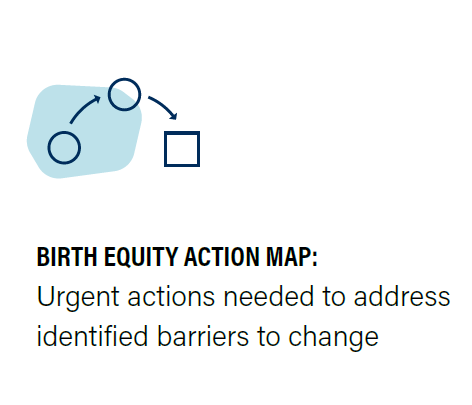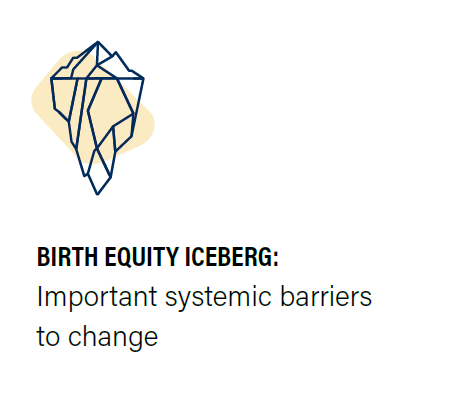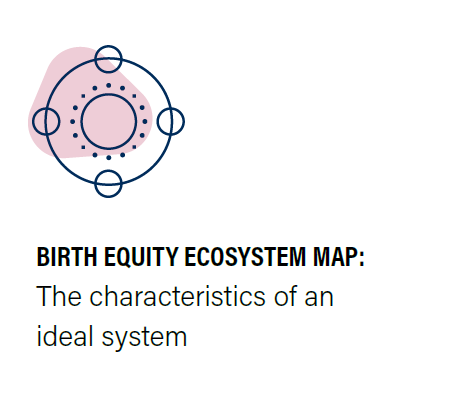Systems Mapping Tools to Advance Birth Equity
The Birth Equity Action Map, Ecosystem Map, and Iceberg were created with funding from the Pritzker Children’s Initiative by AMCHP, UNC Gillings School of Global Public Health, and Vijaya K Hogan Consulting LLC in collaboration with national, state, and local birth equity partners. These tools are intended to accelerate the work of communities, coalitions, and funders in strategically assessing their efforts, identifying opportunities, and committing to specific actions to strengthen the birth equity ecosystem.
Birth Equity Action Map
Key Question: What can we do to strengthen systems to advance birth equity?
The Birth Equity Action Map describes urgent actions needed by specific system actors (i.e., birth equity partners) in the next 5 years to improve birth and racial equity, and highlights where in the system funders can use their leverage to accelerate equity.
Action Themes
- Champion Policy Change: Educate and advocate for policies at the federal, state, local, and organization-level to increase access to the full range of birthing options, improve workforce capacity, and address root causes of birth inequity.
- Co-Design with the Community: Work to create authentic trust-based relationships with community members and organizations and embrace and support community-rooted leadership in co-designing programs and policy change.
- Expand Workforce Capacity: Recruit and train a diverse birthing workforce and strengthen and holistically support the existing workforce to protect from burnout. Provide regular and meaningful bias training, create structures of accountability, and restructure systems to support team-based, trauma-informed, interdisciplinary care models.
- Improve Continuous Care: Strengthen local health systems to eliminate gaps in care throughout the perinatal period, including improved wrap around services and connections between families and system resources.
- Leverage Collaboration: Expand capacity and align efforts through local multi-sector coalitions, cross-state peer learning, authentic community engagement, and support for staff wellness and restoration.
- Restructure Institutions: Restructure institutions to create accountability mechanisms for addressing biases and advancing health equity. Support transformative growth mindsets among leaders and organizations to expand possibilities for change.
- Shift Funding Structures: Restructure funding processes and systems to better support deep systemic changes and apply trust-based philanthropic principles.
- Transform Mental Models through Communication Initiatives: Develop and test targeted messaging, including voices of people with lived experience, to shift mental models of providers, policymakers, and decision makers in the system.
This is a starting point for understanding the system, but we recognize this is not all of the possible needed actions. We hope this will be used as inspiration for individuals, organizations, and coalitions to strategize on their role in advancing birth equity and identify the most urgent and influential actions in their contexts that they can impact.
Utilize the Birth Equity Action Map by navigating the interactive version in Kumu, or review the following resources which break down the map:
- Actions for Specific System Actors
- Actions to Address Specific Barriers to Change
- Full Table of Actions and Descriptions
- Not sure where to start?
Use the following documents to explore actions from the Birth Equity Action Map that specific system actors can take to advance birth equity, as well as potential partners and the barriers to change each action address.
Use the following documents to explore actions from the Birth Equity Action Map that address specific barriers to change, including responsible system actors for each action.
Action to Address:
- Belief Among Decisionmakers That It Is Not Critical to Invest in Workforce, Anti-Racism, or Service Gaps
- Birthing Individuals Only Have Access to What Insurance is Willing to Pay For, Setting a Standard that Limits Choice
- Criminalization of Abortion Care and Non-Hospital Based Birthing Options
- Devaluing of Women and Childbirth and Intense Focus on The Newborn
- Extent that Federal and State Government Prioritize Maternal & Infant Health Equity
- Focus on Individual Care, Rather Than in the Family/Community Context
- Funding Systems Perpetuate Lack of Accountability for Funded Programs to Achieve Results and Engage the Impacted Community
- Health Insurance and Payment Systems That Create and Maintain Inequitable Access to Health Care and Holistic Perinatal Care
- Hospital Performance Data Lacks Disaggregation & Structural Measures
- Inconsistent Investment in Providing Equitable Access to Basic Health, Social, and Economic Services & Support
- Lack of Appreciation for Interconnected Nature of Maternal Health, Behavioral Health, and Health Insurance Policies
- Lack of Support for Diverse Birthing Workforce
- Persistent Implicit Bias Among Providers and Lack of Empathy Towards Pregnant People with Systemically Marginalized Identities
- Practice and Research Focus on the Problem and Not the Solution
- Resistance to Collaboration Across Sectors
- Resistance to Embracing a Transformative Mindset
- Resistance to Including Doulas and Midwives in Care Teams
- Resistance to Public Health, Anti-Racism, Women’s Rights, and Disability Justice Efforts
- Siloed, Restricted, Short-term Funding Cycles & Philanthropic Redlining
- When Referrals Are Made, There is No Coordinated Feedback Structure to Ensure Services are Received
Explore this table for a comprehensive look at what’s in the interactive Birth Equity Action Map, including action ideas, descriptions, responsible system actors, the barriers to change and R4P element being addressed, direct quotes, and action sources.
Our team is here to support you in using these tools! We recognize that even if you are deep in the birth equity system, there is a lot of information here. If you would like an orientation to these materials for you or your partners, assistance facilitating a strategy session using this map, materials tailored to your organization’s or coalition’s specific needs, or if you want general support thinking about how to apply this map to your context, please reach out to us at jsimon@amchp.org.
Birth Equity Iceberg
Key Question: What are the most important systemic barriers limiting our ability to advance birth equity?
This Birth Equity Iceberg captures insights on the barriers that perpetuate inequitable outcomes and limit our efforts to advance birth equity. The Iceberg Model of Systems Thinking was used to prompt for underlying system structures and mental models maintaining birth inequity. The Birth Equity Iceberg helps to define and understand the problem from a systems perspective, which is the first step towards collectively strategizing to shift structures and transform mental models. In using the Birth Equity Iceberg for your own work, you may want to convene your birth equity partners to review and update these systemic barriers to change to ensure that the most pressing barriers in your context are included and prioritized.
The Birth Equity Iceberg
Birth Equity Ecosystem Map
Key Question: What are the characteristics of an ideal system to advance birth equity?
The Birth Equity Ecosystem Map is a holistic, living visualization of the factors and conditions needed to achieve equitable outcomes. This tool provides a thematically organized synthesis of existing wisdom, recommendations, and frameworks to offer a vision of what the ‘ideal’ birth equity system may look like across sectors. The Birth Equity Ecosystem Map helps us appreciate the big picture of what is needed to achieve birth equity.
Four specific system structures were identified as particularly important in shaping birth equity: policy, clinical care, physical environment, and social & economic support. For each of these, we describe the factors and conditions needed. Underpinning these structures, are the critical assumptions, beliefs, and values (i.e., mental models) and cross-cutting characteristics that could create and maintain an equitable system.
Partner Organizations
The following organizations joined a two-part system mapping workshop to co-create these tools and/or participated in feedback sessions throughout the process:
• Alliance for Early Success
• Birthing Cultural Rigor, LLC
• BirthMatters
• Black Mamas ATX
• CityMatCH
• Family Solutions: A Program of the SC Office of Rural Health
• Funders for Birth Justice and Equity
• Georgetown University Center for Children and Families
• Giving Austin Labor Support
• Greater Newark Health Care Coalition
• Hand to Hold
• Healthy Mothers, Healthy Babies Coalition of Georgia
• HRSA’s Maternal and Child Health Bureau
• Institute for Women and Ethnic Studies
• Intermountain Health RMOMS Program
• Mama Sana Vibrant Woman
• Mamatoto Village
• March of Dimes
• Maternal Health Equity Collaborative
• Maternal Mental Health Leadership Alliance
• Merck for Mothers
• Minnesota Indian Women’s Resource Center
• National Healthy Start Association
• National Institute for Children’s Health Quality
• National Partnership for Women & Families
• Our Journ3i
• Philadelphia Department of Public Health
• Preeclampsia Foundation
• Rhode Island Department of Health
• Sedgwick County Health Department
• St. Joseph County Department of Health
• Starting Out Right
• The BEE Collective
• The Reilly Group
• Trenton Health Team
• The U.S. Department of Agriculture
• U.S. Department of Labor
• Utah Pacific Islander Health Coalition
• University of Washington’s Parent-Child Assistance Program




